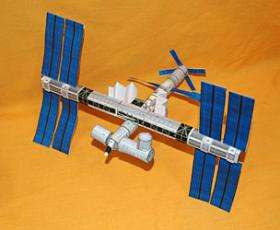Build your own space station

(PhysOrg.com) -- CSIRO's Double Helix Science Club has produced a paper model of the International Space Station (ISS) - the first designed just for children.
The ISS model is part of the special space-themed issues of Scientriffic and The Helix magazines designed to celebrate the International Year of Astronomy. The issues also feature a poster of the solar system, great space images, researcher interviews, a board game, observable universe poster, star chart, hands-on activities and more.
The ISS, the largest and most complicated spacecraft ever built, is being constructed by about 100,000 people representing hundreds of companies, and 16 nations spread over four continents.
The space station’s major purpose is to provide a permanent orbiting facility where world-class research can be conducted in the microgravity environment of space.
CSIRO’s Dr Michael Fenech is leading a team of scientists to help NASA study the effects of high radiation exposure on human DNA. They are also looking at ways diet can help to minimise the effects of high radiation.
Space radiation is one of the main health hazards of spaceflight. It is dangerous because it has sufficient energy to change or break DNA molecules, which can damage or kill a cell.
This research is important to life on Earth because of the similarities between the effects of radiation exposure and the ageing process. Research onboard the ISS into the ‘accelerated ageing’ process is enabling scientists to study how people age over a compressed period of time.
CSIRO is also helping to develop better ways to identify people who are particularly vulnerable to the damaging effects of cosmic radiation.
This will be particularly important for future space missions which could be compromised if astronauts are prone to the genetic harm caused by cosmic radiation exposure.
The research could also lead to ways of identifying astronauts who are genetically resistant to radiation exposure.
To join CSIRO’s Double Helix Science Club and receive Scientriffic and The Helix visit; www.csiro.au/helix .
The model and instructions on how to build the ISS are available at: www.csiro.au/iss .
Provided by Cisco
















